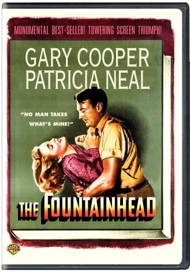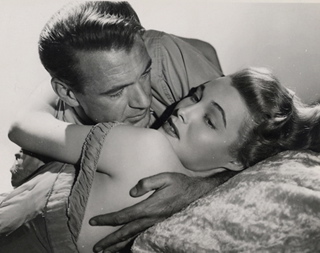| Release List | Coupons | Shop | Reviews | SUBSCRIBE | Forum | DVD Eggs | Video Games | Advertise |
| Reviews & Columns |
|
Reviews DVD TV on DVD Blu-ray International DVDs Theatrical Video Games Features Collector Series DVDs Easter Egg Database Interviews DVD Talk TV DVD Talk Radio Feature Articles Columns Anime Talk DVD Savant Horror DVDs Editor's Blog Silent DVD
|
DVD Talk Forum |
|
|
| Resources |
|
DVD Price Search Customer Service #'s RCE Info Links |
| DVDTalk Info |
|
Review Staff About DVD Talk Advertise Newsletter Subscribe Join DVD Talk Forum DVD Talk Feeds |
 |
The Fountainhead |

|
The Fountainhead Warner DVD 1949 / B&W / 1:37 flat full frame / 112 min. / Street Date October 7, 2006 / 19.98 or as part of Gary Cooper The Signature Collection, 49.98 Starring Gary Cooper, Patricia Neal, Raymond Massey, Kent Smith, Robert Douglas, Henry Hull Cinematography Robert Burks Art Direction Edward Carrere Film Editor David Weisbart Original Music Max Steiner Written by Ayn Rand from her novel Produced by Henry Blanke Directed by King Vidor |
Ayn Rand's dynamic and immensely popular philosophy is said to be most strongly expressed in her 1943 book The Fountainhead, which became an equally controversial Warner Bros. film six years later. Mirroring the uncompromising nature of her fictional hero Howard Roark, Rand personally wrote the screenplay adaptation and insisted that it not be altered. Roark's courtroom speech at the end plays interrupted for more than five minutes.
The Fountainhead is a visual masterpiece. Director King Vidor interprets Rand's intellectual ideas with complimentary images of power and vitality not seen since the days of silent expressionism. Rand's barrage of propaganda-like position speeches are reinforced by visual dynamics that would leave Leni Riefenstahl breathless with envy: Not one second of the film reminds us of real people living in a recognizable world, and Ayn Rand's one-sided tirades and disturbing rhetoric have to be heard to be believed: "The world is perishing from an orgy of self-sacrificing." But the picture is weirdly fascinating.
The Fountainhead is an emotionally powerful piece of cinematic insanity, a movie that bears careful watching yet elicits gales of laughter when shown at festivals and revivals. Gary Cooper and Patricia Neal's overheated, intellectually perverse romance is undeniably entertaining, and a good match for Ayn Rand's personal 'take no prisoners' approach to life and love. It is said that Rand once initiated an affair with her best friend's husband by simply announcing to them both, up front, that she wanted him and that the affair was going to happen. The characters of The Fountainhead continually express their deepest inner needs, and without the slightest restraint.
The Fountainhead isn't strictly a movie; it's a presentation of a radical social philosophy using a soap opera format; it's a lecture fashioned into a fairy tale. The story serves Rand's didactic purpose and her characters represent opposing positions in her argument. A dramatic character is, of course, an artificial construct, and writers strive to make them resemble convincingly real people. When an author places a theme or a message within a character, it's usually reduced to hints and glimpses. Ayn Rand's characters are almost exclusively interior themes and messages; it's as if she reached down the throats of her characters and pulled them inside out. They look like people, but they're walking ideas and arguments.
Howard Roark and company might resemble Olympian gods warring on a philosophical plane, but even the Greek gods had differences of opinion. In the world of Ayn Rand there is only Roark's Super Man and an array of lesser humans that support him even when they oppose him. The script is a rigged debate with the 'correct' side writing both halves of the argument. Ellsworth Toohey, Gail Wynand and Peter Keating speak almost exclusively in hateful, false and often hilariously idiotic boners: "A man abler than his brothers insults them by implication. He must not aspire to any virtue which cannot be shared." "I want you to know that I have very little respect for anything on Earth." "Howard, I'm a parasite. I've been a parasite all my life."
Faced with such paper lions, Roark has only to state a few reasoned opinions to come off as a relative genius. The Fountainhead is definitely propagandistic in that its apparent conflict is an illusion. The only real conflict is between the author and the viewer. "I'm right and you must agree with me," Ms. Rand argues. And she has the cinematic might of King Vidor and the magnetically persuasive Gary Cooper to back her up. When it comes time to hear a dissenting opinion, it's always obvious rubbish from an unworthy spokesman. John Doucette, a specialist in moronic western bad guys, plays the uncouth consulting architect that desecrates Roark's Courtland Towers project. Doucette grouses in his best lynch-mob voice, "We wanna express our creativity too."
The Fountainhead is a technically sophisticated update of the style previously seen in Soviet agit-prop movies. Everything exists to further the author's argument. At the center is Howard Roark, a granite-hard man of unmatched virility. Proud and unbroken when forced to give up his New York office, Roark works an air cutter in a marble quarry. The sight of his sweaty arm instantly arouses the interest of the soul-sick heroine; she hallucinates the phallic jackhammer arm in her mirror. Howard is integrity personified, a man of few words but forceful in action. It's a perfect role for Gary Cooper, who cannot possibly have grasped the full meaning of Ayn Rand's book; we're told that even King Vidor asked for authorial clarifications for how the characters should behave.
Around Howard orbit lesser, flawed specimens, all carefully positioned to enhance his superiority. Architectural mentor Henry Cameron (Henry Hull) has Roark's ideals but lacks his stamina and succumbs to alcoholism. "A building's shape must serve its function," rails Cameron, simply repeating the mantra of an earlier school of German design. Peter Keating is the sell-out version of Howard Roarke, an architect without convictions who asks Dominique to marry him to become her father's partner. Keating's own incompetence and cowardice eventually catch up with him. In the book, Peter Keating would rather paint but is forced into architecture by a domineering mother. He ditches the true love of his life to pursue his career. By contrast, Howard appears to have no relatives. His individualist stance forbids him from depending on others. Anyone who wants to be a part of his life must come to him, on the same terms that he imposes on his clients.
Gail Wynand is the warped alternative to Howard Roark, a wildly successful tycoon who made his fortune by publishing a tabloid for the masses. Wynand openly expresses his contempt for his customers and cynically distorts the truth to increase his circulation. When Wynand is shown that his power is an illusion (why?), his personality self-destructs. Architecture critic and rabble-rouser Ellsworth Toohey is a demagogue who uses Wynand's newspaper to generate a hateful campaign against Roark. His only philosophy is the destruction of the higher values that Roark represents. Toohey revels in his villainy, but Roark doesn't even acknowledge his existence.

Dominique Francon is introduced in the giddily symbolic act of destroying a statue. Her elevated consciousness has led her to a state of despair in which she perversely attempts to drag Howard down to save him from the dogs of society. Howard instead provides the sexual motivation that redeems Dominique. The Fountainhead's sexual politics are far removed from any kind of rational discussion. When asked why she included a rape scene in her idealized romance, Ayn Rand's response was, "If it was rape, it was rape by engraved invitation." Rand's model woman has lofty ideals but finds satisfaction by becoming the sex slave of the 'perfect' man: Her idea of devotion is to attempt suicide in the ruins of one of his buildings. The film's final image tops the sexually charged jackhammer and statue with a glorious vision, Dominique's ride to the stratosphere on Roark's towering .... edifice. It's an image out of H.G. Wells' The Food of the Gods: Like King Kong, Howard Roark has conquered the world. 1
Ayn Rand's philosophy is called Objectivism, and it begins with the proposition that the real world is physical in nature, not spiritual: Actions count, not feelings or faith. Controversial aspects include the idea that people are independent individuals and therefore not responsible for one another: altruism is a sham. Rand's ideas entered from outside the philosophical establishment and for years were ignored at the academic level, even when The Fountainhead became favored reading material in high school classrooms. It's now more popular than ever.
Director King Vidor gives The Fountainhead a modernistic sheen in keeping with its visionary ideals. Former effects cameraman Robert Burks makes many shots into thematic statements, often compressing information within the frame as one would design a silent movie image. The ambulance scene frames Henry Cameron and Howard Roark in front of a procession of New York buildings that seem like mourners at Cameron's funeral. In the marble quarry representing the masculine power of the Earth, Roark stares upward at the spectral figure of Dominique, silhouetted like a sacrificial offering. Roark works in tiny offices and shacks that contrast with the oversized meeting rooms, sterile apartments and business throne rooms that dominate the rest of the movie. The film's most difficult design task was the supposedly revolutionary works of Howard Roark, buildings so distinctive that anyone can recognize their maker. These creations are represented by a parade of concept drawings with jutting profiles, inverted shapes and pointy protuberances. When the drawings dissolve to the completed buildings, architecturally-minded viewers usually laugh out loud at faux-futurism that would fit perfectly in a Duck Dodgers cartoon.
The Fountainhead wasn't treated kindly by critics and didn't do well in big urban areas, but the country as whole responded well to Gary Cooper as "Mr. Deeds Conquers the Humanists." The movie says that the unwashed masses are worthless, and proposes the discomforting thought that the inheritors of the Earth shall be artisan-architects responsible to nothing but their own consciences. Audiences shocked at the idea that a zealot would resort to terrorism to achieve a political goal, usually applaud when Howard Roark dynamites an entire skyscraper because it violates his personal ideals.
Warner DVD's disc of The Fountainhead replicates the clean B&W lines of Robert Burk's slick cinematography. The visuals combined with Max Steiner's beautiful score energize the screen, creating the best possible platform for Ayn Rand's dizzying dialogues. The final scene is a triumph of form over content, as Dominique Francon experiences sexual ecstasy on her way to the top of the world's tallest building.
In addition to a trailer, Warners' disc offers a featurette on The Making of The Fountainhead that sketches the printable facts on Ayn Rand's experience in Hollywood. It only touches on the intriguing philosophy that animates her Super Man Howard Roark character. Nothing less than a full book could do justice to her arguments.
On a scale of Excellent, Good, Fair, and Poor,
The Fountainhead rates:
Movie: Excellent
Video: Excellent
Sound: Excellent
Supplements: Featurette The Making of The Fountainhead, Trailer
Packaging: Keep case
Reviewed: November 2, 2006
Footnote:
1. Curiously, the only film with a structure remotely similar to The Fountainhead is another visionary story guided by a literary author, H.G. Wells' Things to Come . It's an equally didactic unfolding of a grand philosophy, and is also packed with stilted oratory disguised as dialogue.
Return
Reviews on the Savant main site have additional credits information and are more likely to be updated and annotated with reader input and graphics.
| New Review: |
|
|
| Special Offer |
|
| Home | Release List | Coupons | Shop | Reviews | Forum | Video Games | Price Search | Advertise |






